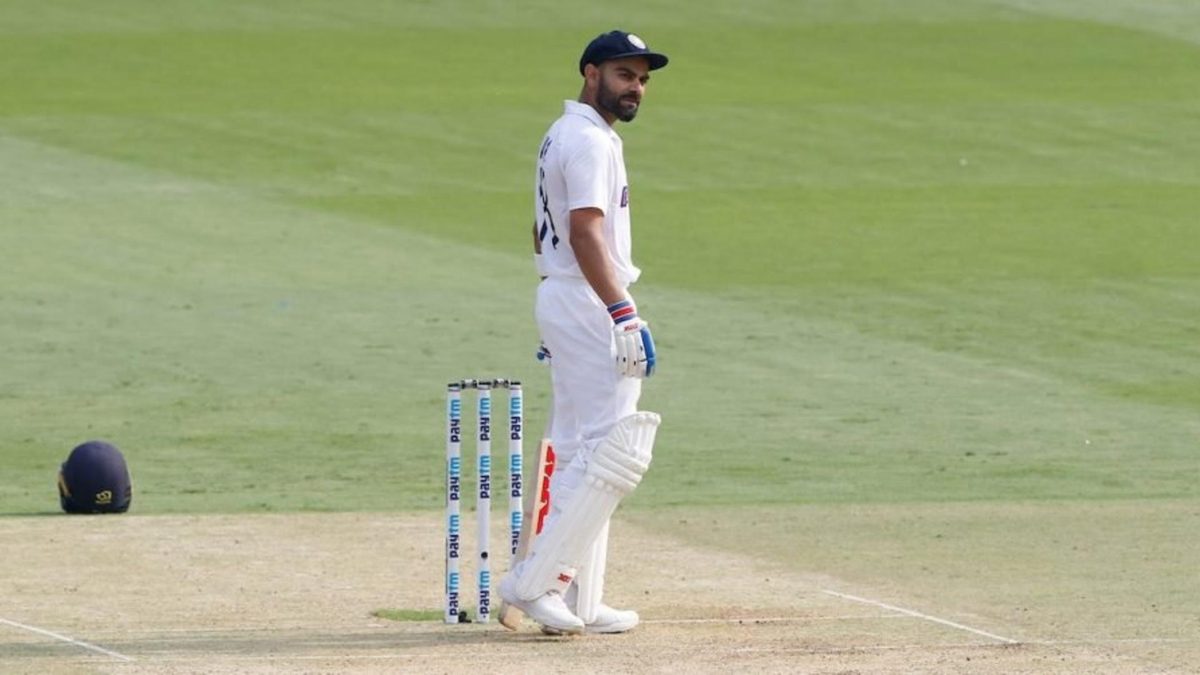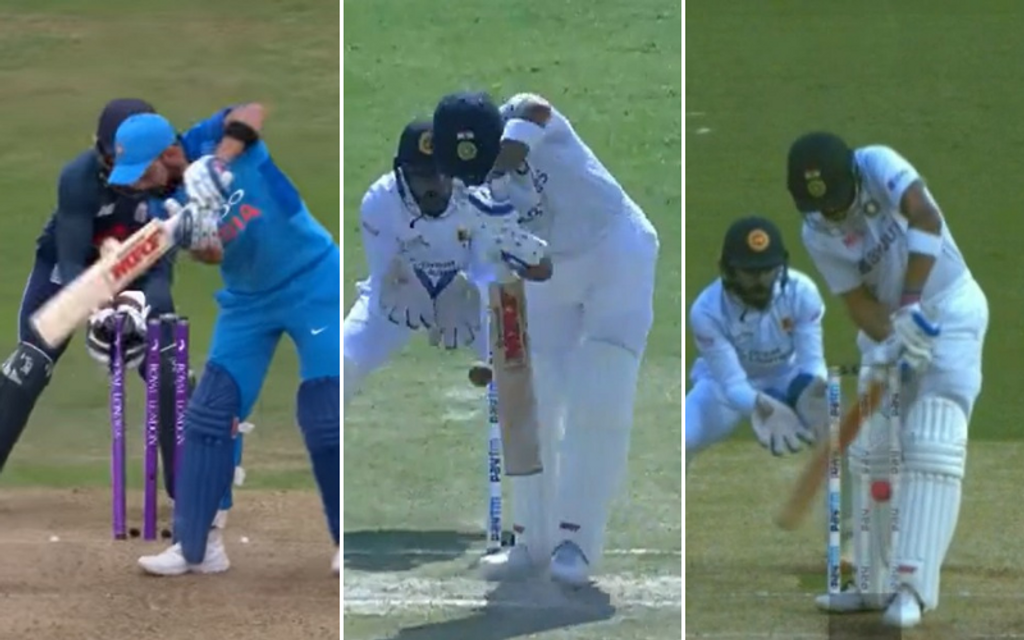
Virat Kohli’s international century drought has exceeded two years and while there have been a few glimpses of his pre-2020 genius, Shashwat Kumar has observed a rather worrying pattern that seems to be undermining whatever good he is doing at the crease.
Prior to 2020, Kohli was widely regarded as the greatest all-format batter to have ever graced the sport. There was plenty of reason behind it too: he’d scored tons of runs across formats and had done so in an assortment of conditions.
So much so that when his ‘blip’ began, people termed it an aberration. Some even suggested that he would emerge from this slump stronger and continue to plunder runs for fun again. While that can still happen, the dry run has continued, and his recent outings have underlined a slight technical chink in his armour. It isn’t a lot and is certainly something that can be corrected. But as long as it exists, bowlers will always have a chance against Kohli, which, considering his pre-2020 dominance, is enough to cause more than a furrowed brow or two.
Over the years, Kohli has been labelled as one of the best players of spin bowling. He has shots all around the park and his array of strokes meant that he always seemed a step ahead of the bowlers, rarely allowing himself to fall into a rut.
Kohli’s recent struggles against spin
In recent times, though, the former India skipper has begun encountering a sticky patch against spinners, especially at home and in the longest format. As things stand, the right-handed batter has been dismissed 11 times in Test cricket in India since the start of 2020. Nine of those dismissals have come against spin, with the likes of Ajaz Patel, Dhananjaya de Silva, Dom Bess, Jack Leach, Lasith Embuldeniya, Moeen Ali and Rachin Ravindra enjoying success.
With leg-spinners not really in vogue in Test cricket nowadays, it becomes clear that Kohli has been getting out to each variety of spin that he has faced. Most of these have come either when he has lunged at the ball or has gone too deep into his crease. The counter-argument will be that going fully forward or fully back is much better than getting stuck on the crease and that Kohli has, throughout his career, been a master at deploying this method. But getting out nine times to spin, which includes four LBWs and four ‘Bowled’ dismissals, illustrates that something might have to be tweaked.
Kohli had a tendency to rock back and work the ball into the leg side even when he was in his peak form. The short-arm whip/pull/jab, played through mid-wicket was one of his most productive strokes. Quite often, he would force the bowler to bowl marginally short, only for Kohli to camp deep in his crease and capitalise.
It could possibly help if the former skipper got into a slightly square-on position to execute such shots. If he were to find himself completely side-on, he might have trouble accessing the ball easily. That hasn’t changed in the past couple of years too. The problem, though, is that he has, quite frequently, picked the wrong balls to do so.
In the first Test against Sri Lanka, Kohli went back to a relatively good length delivery bowled by Embuldeniya. With the ball zipping off the surface, Kohli could only waft at the delivery and see it smashing onto the top of off stump. A game later against Jayawickrama, the right-handed batter got onto the back foot. The ball might have kept a little low and was a touch fuller than Kohli expected. Had he come forward, though, it could have been offset.
This tendency was also exploited by Adil Rashid in 2018 during an ODI at Headingley. On that occasion too, Kohli saw the slightly flatter trajectory and positioned himself to whip the ball through mid-wicket. The ball turned square, but by the time Kohli wound up playing his shot, he found himself in a tricky position.
The other drawback of getting too square-on is that the bat will then inevitably come down at an angle, thereby exposing both edges and the stumps – something that has happened with Kohli, especially when the ball has spun a little.
 Kohli’s dismissals against Rashid (L), Embuldeniya (C) and Jayawickrama (R)
Kohli’s dismissals against Rashid (L), Embuldeniya (C) and Jayawickrama (R)
Is he not picking lengths as quickly?
Another facet that probably points towards the right-handed batter not picking the right length is the number of LBW and ‘Bowled’ dismissals in the past couple of years against spin (eight out of nine innings at home since the start of 2020).
Moeen Ali, in particular, pounced on this shortcoming in the second Test at Chennai in February 2021. He looped the ball outside off stump and enticed Kohli into an expansive cover drive. The ball, which was a lot shorter than the batter anticipated, ripped past his inside edge and clattered the stumps.
During the pink-ball Test in that series, Kohli picked a relatively fuller delivery to cut against Leach. The ball hurried onto him and he could only chop it back onto his stumps. The LBW dismissals, meanwhile, happen because the 33-year-old, just like he does for the leg-side whip, shapes up for the cover drive, meaning that his foot is already planted on off stump.
Hence, when the ball slants into him, he defends with bat and pad very close together, thereby opening up a chance for the ball to miss the bat and hit Kohli somewhere around off stump – as happened at Mumbai in December 2021 against Ajaz Patel. He has tried taking a leg-stump guard to avoid planting his front foot on off stump. The picking of length, however, has continued to plague him.
Should he continue playing the strokes he usually does?
The trade-off here is pretty clear. Kohli has, throughout his career, never compromised on playing his strokes. If anything, he has always maintained that he can, despite the obvious demerits of those shots, execute it better and dominate. Now, some sort of doubt might just have crept in. He seems to be picking the length a little later than what he has done for the majority of his career, probably the only thing from a technical standpoint that is holding him back from scaling the heights he once did.
So much so that you feel his paucity of runs are not because of a lack of concentration, form, luck or temperament. Instead, the technique that has worked so well for him has begun malfunctioning – partly because his weaknesses has been openly exposed but largely because his picking of length, the central crux of his modus operandi, might not be as good as it once was.
Having said that, Kohli can never be written off. He remains a top-drawer batter and someone capable of emerging from this downturn relatively unscathed. What is different this time out, though, is he doesn’t seem as invincible as in previous years. That, in itself, would be a tough pill to swallow, especially for someone of his pedigree. Yet, he has found ways to recover in the past: whether it be a torrid tour of England in 2014 or an indifferent series against Australia in 2011/12.
India, however, would hope that that happens sooner rather than later.








